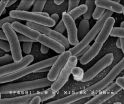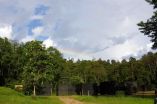(Press-News.org) A group of researchers from Russia, Belarus and Spain, including Moscow Institute of Physics and Technology professor Yury Lozovik, have developed a microscopic force sensor based on carbon nanotubes. The device is described in an article published in the journal Computational Materials Science and is also available as a preprint.
The scientists proposed using two nanotubes, one of which is a long cylinder with double walls one atom thick. These tubes are placed so that their open ends are opposite to each other. Voltage is then applied to them, and a current of about 10nAflows through the circuit.
Carbon tube walls are good conductors, and along the gap between the ends of the nanotubes the current flows thanks to the tunnel effect, which is a quantum phenomenon where electrons pass through a barrier that is considered insurmountable in classical mechanics.
This current is called tunneling current and is widely used in practice. There are, for example, tunnel diodes, wherein current flows through the potential barrier of the p-n junction.
Another example is a scanning tunneling microscope (STM), in which the surface of a sample is scanned with a very sharp needle under voltage. The needle slides along the surface, and the magnitude of the current flowing through it shows the distance to the sample with such accuracy that the STM can detect protrusions one atom high.
The authors of the article used the relationship between the tunneling current and the distance between the ends of the nanotubes to determine the relative position of the carbon nanotubes and thus to find the magnitude of the external force exerted on them.
The new sensor allows the position of coaxial cylinders in two-layer nanotubes to be controlled quite accurately. As a result, it is possible to determine the stretch of an n-scale object, to which electrodes are attached. Calculations made by the researchers showed the possibility of recording forces of a few tenths of a nN(10-10newtons). To make it clearer, a single bacterium weighs about 10-14newtons on average, and a mosquito weighs a few dozen mcN (10-5 N).However, the device developed by the physicists may find application beyond micro scales.
A double-layered coaxial nanotube is akin to a microscopic cylinder with a sliding piston. Such a system has already been considered by a number of other researchers as a potential part for various types of nanomachines. Nanotubes have been proposed for the role of micromanipulators, or connecting "studs" for complex mechanisms, and they may even be used for data storage; the position of the inner "piston" may encode one bit of information or more.
Furthermore, calculations have shown that it is possible to create a combined device, where inside a two-layer carbon nanotube there will be magnetic fullerenes. When placed in a magnetic field, a power will emerge, which could be measured by changes in the magnitude of tunneling current. This will convert the force sensor into a magnetic field sensor.
MIPT's press office would like to thank Andrey Popov for his invaluable help in writing this article.
INFORMATION:
Scientists develop force sensor from carbon nanotubes
A group of researchers from Russia, Belarus and Spain, including Moscow Institute of Physics and Technology professor Yury Lozovik, have developed a microscopic force sensor based on carbon nanotubes
2014-06-30
ELSE PRESS RELEASES FROM THIS DATE:
A first: Scientists show bacteria can evolve a biological timer to survive antibiotics
2014-06-30
The ability of microorganisms to overcome antibiotic treatments is one of the top concerns of modern medicine. The effectiveness of many antibiotics has been reduced by bacteria's ability to rapidly evolve and develop strategies to resist antibiotics. Bacteria achieve this by specific mechanisms that are tailored to the molecular structure or function of a particular antibiotic. For example, bacteria would typically develop drug resistance by evolving a mutation that breaks down the drug.
Researchers at the Hebrew University of Jerusalem set out to determine if they could ...
More carbohydrates make trees more resistant to drought
2014-06-30
Water is the limiting factor for many plants and trees. Consequently, there are grave concerns that the rainfall patterns altered by climate change could trigger a forest decline on a global scale. According to climate researchers, Switzerland is also affected: The climate models even project hotter and drier summers for this country. An international research team headed by Michael O'Brien, an ecologist at the University of Zurich, is now studying which factors govern the resistance of tropical trees to periods of drought. As the scientists reveal in their study published ...
Women's groups recommended by WHO as an intervention to cut newborn deaths
2014-06-30
The World Health Organisation has recommended an intervention developed and tested by partners in four countries and UCL researchers to improve maternal and newborn health. The intervention involves groups of women working together in a four-stage facilitated process: 1) Identifying problems during pregnancy, delivery, and post-partum; 2) Developing strategies to address these problems; 3) Implementing these strategies; and 4) Evaluating the strategies.
A meta-analysis of research into Participatory Women's Groups was conducted by Dr Audrey Prost and others, largely ...
Cocaine addiction: Phase-specific biology and treatment?
2014-06-30
Philadelphia, PA, June 30, 2014 – Current pharmacotherapies for addiction follow the dictum "one size fits all". Medications are prescribed in the same way for all patients, regardless of whether they have just started experimenting with a drug or have an established drug habit. Even more troubling, there are no FDA-approved pharmacotherapies for some addictions, such as compulsive cocaine use.
Perhaps testing drugs in ways that focus on particular phases of addiction or particular clinical features of addiction, such as a patient's level of impulsivity, might advance ...
Silver in the washing machine
2014-06-30
If it contains 'nano', it doesn't primarily leak 'nano': at least that's true for silver-coated textiles, explains Bernd Nowack of the Technology and Society division at Empa. During each wash cycle a certain amount of the silver coating is washed out of the textiles and ends up in the waste water. Empa analysed this water; it turned out that nano-coated textiles release hardly any nano-particles. That's quite the opposite to ordinary coatings, where a lot of different silver particles were found. Moreover, nano-coated silver textiles generally lose less silver during washing. ...
Gene variants found that increase pain sensation after common childhood surgery
2014-06-30
In the first genome-wide analysis of postsurgical pain in children, pediatric researchers identified variations in genes that affect a child's need for pain-control drugs. The findings suggest that at some point physicians may calibrate pain-medication dosages according to a child's individual genetic makeup.
"Although this research is only a first step for our team, it provides tremendous new insight into the biological mechanisms and brings us a little closer to personalizing medicine for pain control," said Scott D. Cook-Sather, M.D., a pediatric anesthesiologist at ...
It may take guts to cure diabetes
2014-06-30
New York, NY (June 30, 2014) — By switching off a single gene, scientists at Columbia University's Naomi Berrie Diabetes Center have converted human gastrointestinal cells into insulin-producing cells, demonstrating in principle that a drug could retrain cells inside a person's GI tract to produce insulin.
The new research was reported today in the online issue of the journal Nature Communications.
"People have been talking about turning one cell into another for a long time, but until now we hadn't gotten to the point of creating a fully functional insulin-producing ...
Newly identified gene provides reliable visual cue for oil palm fruit ripeness
2014-06-30
A genetic discovery by a team of scientists from the Malaysian Palm Oil Board (MPOB), aided by scientists from Orion Genomics, paves the way for increased production of palm oil, which accounts for 45 percent of the world's edible oil, while also helping to conserve sensitive wild habitats at risk of being turned into agricultural land.
In the study published in the journal Nature Communications, the scientists identified the VIR gene as responsible for fruit color. Currently, the majority of the oil palm fruit harvested in Malaysia and Indonesia is the nigrescens variety ...
No link between fertility drugs and breast, ovarian and uterine cancers
2014-06-30
Munich, 30 June 2014: There is "little evidence" that the use of conventional fertility hormones used for ovarian stimulation in the treatment of infertility increases the long-term risk of breast and gynecological cancers, according to the results of a substantial 30-year follow-up study. However, the extended use of clomiphene citrate was associated with a higher risk of breast cancer among women who had used the fertility drug for 12 cycles or more. Gonadotrophins, more commonly used for ovarian stimulation today, were not generally associated with any increased risk, ...
Children born to women after fertility treatment at greater risk of psychiatric disorders
2014-06-30
Munich, 30 June 2014: Children born to women with fertility problems have a higher risk of psychiatric disorders than naturally conceived children. The increase in risk was described as "modest" by researchers from Denmark, but was found to persist throughout childhood and into young adulthood.
The results, which are presented today at the 30th Annual Meeting of ESHRE in Munich by Dr Allan Jensen of the Danish Cancer Society Research Center at the University of Copenhagen, were derived from a register study of all children born in Denmark between 1969 and 2006.
From ...
LAST 30 PRESS RELEASES:
School meals could unlock major gains for human and planetary health
Menopause hormone therapy does not appear to impact dementia risk
Signature patterns of brain activity may help predict recovery from traumatic brain injury
Dresden study uncovers new key mechanism in cancer cells
New species are now being discovered faster than ever before, study suggests
Cannabis-based products show limited short-term benefit for chronic pain, with increased risk of adverse effects
Cannabis products with more THC slightly reduce pain but cause more side effects
Clearing the brain of aging cells could aid epilepsy and reduce seizures
Brain injuries linked with potential risk of suicide, new study finds
New technique lights up where drugs go in the body, cell by cell
New study finds movement of fishing fleets can reveal shifts in marine ecosystems
Embargoed: New evidence points to potential treatment for vascular dementia
Study uncovers disrupted brain balance in alcohol dependence
Working in groups can help Republicans and Democrats agree on controversial content moderation online
Structural findings reveal how distinct GPCR ligands create different levels of activation
Anything-goes “anyons” may be at the root of surprising quantum experiments
UC review: Maximizing workplace opportunity for veterans
From generation to complex control: Metasurfaces make perfect vortex beams "within reach"
Thin-film lithium niobate-based detector: recent advances and perspectives
Exploring why some people may tend to persistently make bad choices
How cells balance their protein levels
Nirsevimab vs RSVpreF vaccine for RSV–related hospitalization in newborns
Effectiveness and impact of maternal RSV immunization and nirsevimab on medically attended RSV in US children
AI gives scientists a boost, but at the cost of too many mediocre papers
Next-generation vision model maps tree growth at sub-meter precision
Genes aren’t destiny for inherited blindness, study shows
MIT study: High-fat diets make liver cells more likely to become cancerous
Exposure to multiple fine particulate matter components and incident depression in the US Medicare population
Risk of burdensome health care spending over time in the US
Nirsevimab against hospitalizations and emergency department visits for lower respiratory tract infection in infants
[Press-News.org] Scientists develop force sensor from carbon nanotubesA group of researchers from Russia, Belarus and Spain, including Moscow Institute of Physics and Technology professor Yury Lozovik, have developed a microscopic force sensor based on carbon nanotubes






